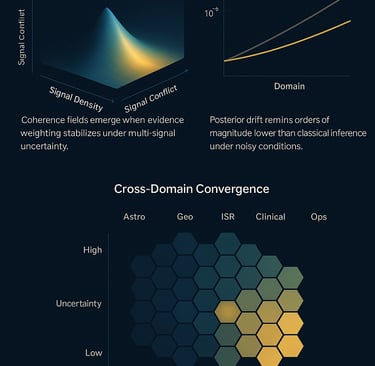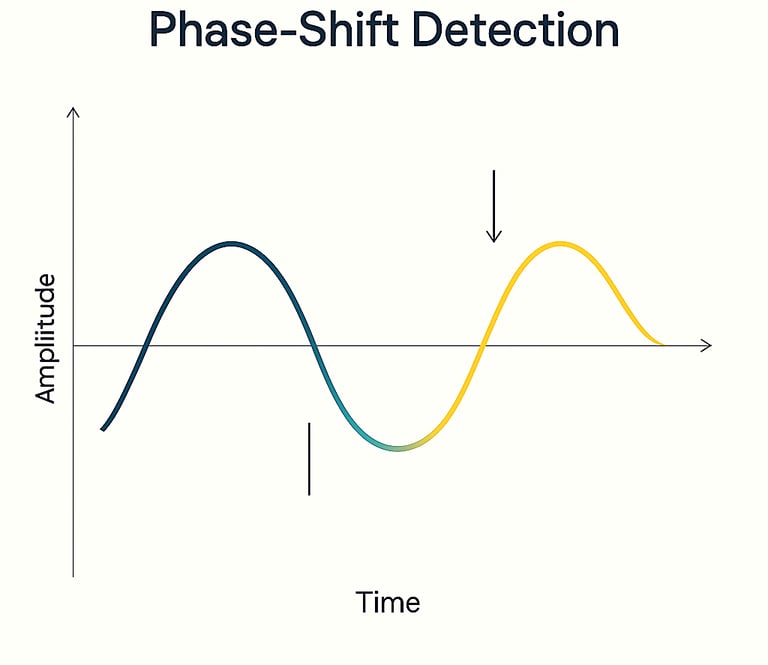
Forlytica Research™
Evidence-Weighted Reasoning for High-Uncertainty, Fast-Changing Systems
Forlytica’s research program applies a disciplined Bayesian inference architecture designed to restore coherence inside high-dimensional, rapidly shifting, and adversarial evidence environments.


• Evidence stability
• Predictive coherence
• Falsifiable outputs
• Transparent, reproducible priors
• Physics-grounded reasoning
• Cross-domain generalizability
Many modern systems operate under overlapping or conflicting signals — astrophysical signatures, ISR telemetry, geophysical indicators, operational data, or clinical metrics. Classical inference pipelines often diverge as uncertainty compounds.
Evidence Coherence Under Multi-Signal Uncertainty
The “Evidence Coherence Surface” visual illustrates how structured coherence forms as a function of signal density and signal conflict, producing a stable, testable inference field instead of fragmentation. This phenomenon is foundational to Forlytica’s cross-domain reliability.
Forlytica research demonstrates that coherence fields can emerge even inside multi-signal uncertainty when evidence weighting is dynamically stabilized.
Traditional Bayesian pipelines degrade when:
• priors collapse,
• evidence is noisy or inconsistent,
• structural changes accelerate,
• or observational gaps widen.
Forlytica’s research demonstrates that posterior drift can remain orders of magnitude lower than classical inference under identical noisy conditions — preserving predictive stability even as the system evolves.
The "Posterior Drift Suppression" plot compares domain-level drift trajectories, illustrating how structured evidence weighting maintains long-horizon coherence. This stability is essential for mission-critical, safety-critical, and time-sensitive decision environments.
Posterior Drift Suppression Across Domains
Cross-Domain Convergence Under Structural Uncertainty
Different domains express fundamentally different uncertainty structures:
• Astrophysical — sparse signals, long baselines, nonlinear dynamics
• Geophysical — structural breaks, drift windows, multi-scale transitions
• ISR/Telemetry — partial information, contradictory sensors
• Clinical — heterogeneous signals, rapidly shifting priors
• Operational — degraded conditions, real-time constraints
Despite this diversity, Forlytica research identifies common convergence behaviors: evidence fields from disparate domains often align into similar coherence structures when stabilized through disciplined Bayesian weighting. The “Cross-Domain Convergence” visualization demonstrates this effect: uncertainty structures differ, but convergence patterns emerge across astro, geo, ISR, clinical, and operational environments. This is the scientific backbone of Forlytica’s ability to generalize across domains without exposing internal architecture.


Our work emphasizes:
Forlytica Research Group™
Independent Scientific Analysis Division
United States
Public Briefings
All Forlytica publications released on this site represent our public-domain posture:
evidence-weighted reasoning, transparent priors, and falsifiable predictions.
No proprietary internal methods, algorithms, or computational architectures are disclosed.
© 2025 Forlytica. All rights reserved.
Scientific Integrity Notice
Forlytica briefings are derived exclusively from observable data,
reproducible physical models, and domain-standard analytical frameworks.
All conclusions remain strictly naturalistic unless contradicted by evidence.
